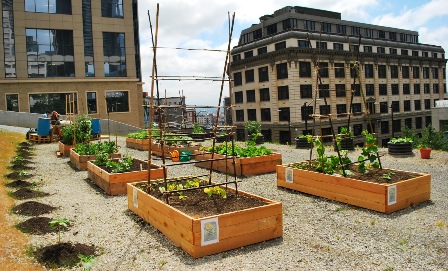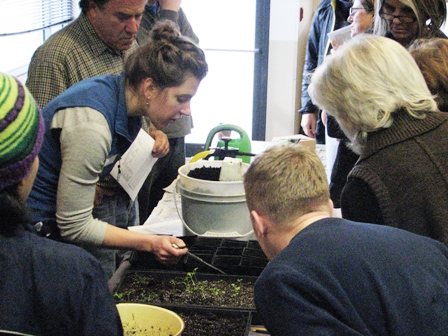One of the goals of the Seattle Community Farm is to engage the community in growing and sharing food. Therefore, we only do outreach in the immediate neighborhood around the farm, rather than engaging with large groups from anywhere in the city. The immediate neighborhood currently consists of about twelve blocks of residences, with roughly 180 families, and the surrounding area is significantly larger. Because that neighborhood is so diverse, we have tried to do outreach in many ways so as to reach as many people as possible.
Translation and Interpretation
In a neighborhood where there are immigrants and refugees who speak 56 different languages, it’s important to reach people in their own languages. Following are a few of the lessons we’ve learned this year and recommended tips for using translation and interpretation services to do outreach:
“Translation” refers to written materials, and “interpretation” refers to spoken interactions. Figure out which languages are most widely spoken, and offer services in those languages.
-
Note that many people who speak regional dialects or less-widely spoken languages also speak a more common language.
-
For example, many Ethiopian people speak Tigrinya in the home, but also understand Amharic, which is used for official business in Ethiopia.
Translations of text or flyers are useful, although some immigrants may lack high levels of literacy in their native language. Translated materials are also good to give to interpreters so they have a reference in both languages. Putting the translations in smaller type makes sense logistically, but make sure the text is readable and eye-catching.
-
This is an example of one of our translated fliers.
Interpreters already exist in both cultures in some ways, so they are often very good at explaining cultural norms that may be incomprehensible to you. If people will be asking questions through interpreters, allot enough time to interpret both the questions and answers to other language groups (who didn’t ask the question). When making flyers in multiple languages, think critically about the size and placement of the translations. Interpreters, especially those who live in the community, are great resources for reaching people in that cultural group. They are also good people to ask about what is polite in their culture. Always allot more time for events when using interpreters. The same activity takes roughly 40% longer when going through interpretation.
Community Infrastructure

Every community has certain groups, organizations, or faith communities that attract a lot of people and hold public influence. Connecting with these groups to build and maintain good relationships is critical. In our context, we make sure to establish relationships with groups that serve all the major cultural groups in the neighborhood (i.e. East African immigrants and refugees, SE Asian immigrants and refugees, low income renters, and middle class and wealthy homeowners).
Following are some good strategies and things to keep in mind when connecting with existing community groups.
-
Someone probably has a list of all the groups of a particular type. For example, a non-profit or social service agency likely keeps a list of additional services offered in the community.
-
Make sure not to assume that this list is comprehensive until you’ve done some investigating yourself. You never know when one group may have a grudge against another and won’t give out their information.
-
Visiting groups is a great way to network. You may not get any volunteers directly from these visits, but they help with visibility of the project, and relationship building.
-
Visiting groups may mean participating in the activity they do, or giving a presentation on the project.
-
“Cultural capitol” refers to the kind of status you hold in a community, and it’s a good thing to think about when doing outreach. If you are well respected, and well connected, in the community, people will be more likely to participate in the programs you offer.
-
Elders often have high status in groups organized around cultural affinity. They may be your initial contact to establish relationships within a cultural group.
-
This doesn’t mean you have to adopt their culture, but figuring out which pieces are important to respect and uphold is useful.
-
For example, most Somali immigrants are Muslims, and many of them place a high value women’s modesty. As a non-Muslim woman, I am not expected to follow the same standards, but I try not to wear clothing (for example, tank tops) that is far outside their cultural norm.
-
Get to know well-respected community members. This is good “cultural capitol” as they will know who else you should connect with.
-
Be prepared for groups organized around a culture or religion different from your own to do things differently than you might expect. Engaging in their customs is a great way to show people you’re trying to connect with them as people - a good way to start a relationship.
-
Make it a point to attend events in the community, even if opportunities to present the project or distribute flyers are limited. Talking to people in a more social context is often a better way to recruit volunteers and supporters.
Volunteer Appreciation
Everyone likes to be appreciated for the work they’re doing. Thanking volunteers also allows you to make a pitch for their continued involvement with the project. We sent thank you cards to our volunteers at the end of the summer with a reminder that the growing season continues through the fall. Thank-you cards are a good way to acknowledge volunteers individually and to show your appreciation for their hard work. Find something personal to say to each of them.
We also hold a Harvest Celebration and other volunteer potlucks. It’s nice to get people together just to socialize, not work. Being a farm, cooking and eating together are natural ways of doing that.
Paperwork
When a new volunteer starts at the Farm, we hand them a packet with the necessary paperwork. This includes a Volunteer Application, a Media Release, and a survey that is required by one of our grants. We then scan these into our computer system, so that it's all in one place.

 Outreach
Outreach